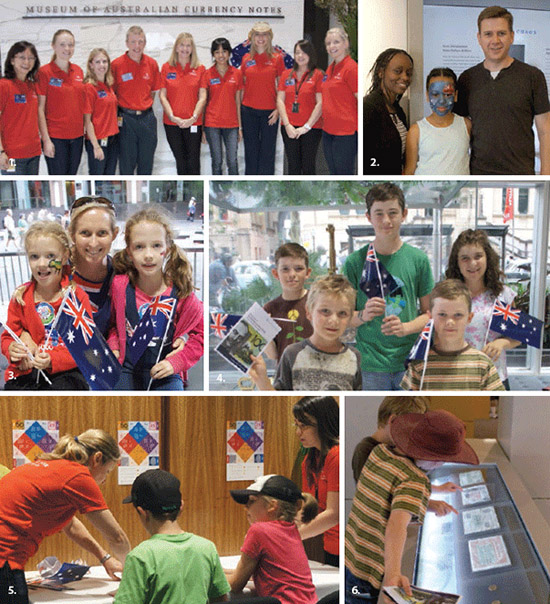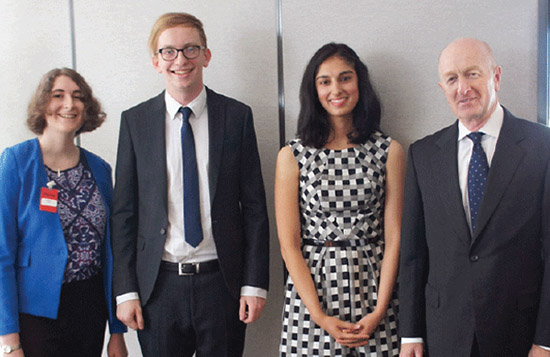Reserve Bank of Australia Annual Report – 2014 Community Engagement
Activities of the State Offices
In addition to its Head Office located in Sydney, the Reserve Bank has offices in Adelaide, Brisbane, Melbourne and Perth. These offices play an important role in the Bank's liaison program and form a key component of the Bank's communication with members of the public, business, government, community organisations and academia in their respective states.
The Reserve Bank devotes significant resources to building relationships across a broad cross-section of the community, with a view to gaining firsthand insights into conditions in different industries and regions in the national economy. The staff involved in the liaison program conducted almost 1,000 interviews around the country during the year in review, with information from these meetings reported to Head Office and incorporated in the material prepared for the monthly Reserve Bank Board meetings and the quarterly Statement on Monetary Policy. In this way, information obtained from liaison is used to complement standard sources, such as data from the Australian Bureau of Statistics and business surveys, in forming the Bank's assessments of the economy.
Staff in the State Offices also play a role in the Reserve Bank's efforts to keep the public informed of its evolving views on the economy. They interact with a broad cross-section of the community, regularly giving presentations on economic developments to business groups, community organisations and educational institutions in state capitals and regional centres. They facilitate regular visits by senior staff from Head Office's Economic Group to meet with liaison contacts and provide briefings on the economy to various groups in the community. Staff from the State Offices also visit Tasmania and the Northern Territory to gather information on economic conditions in those parts of Australia.
Liaison with Small Businesses
The Reserve Bank continues to convene its Small Business Finance Advisory Panel, which was established in 1993 and meets annually to discuss issues relating to the provision of finance and the broader economic environment for small businesses. Membership of the Panel is drawn from a range of industries across the country. The Panel provides a valuable source of information on the financial and economic conditions faced by small businesses. The Bank's liaison program also involves Bank staff meeting with a number of small businesses and small business groups.
Museum of Australian Currency Notes
The Reserve Bank's Museum houses a permanent collection of artefacts, hosts periodic exhibitions and offers regular talks and tours. The permanent collection portrays the story of Australia's banknotes against the backdrop of the nation's broader social and economic history. It welcomes visitors with a display of the types of money used before Federation – from an early colonial rum bottle through to Australia's first gold coins. Visitors can then view various banknotes produced since the first Australian note series in 1913–1915. Finally, the Museum focuses on Australia's polymer banknotes, describing their design, security features and potential for recycling. When viewing the collection, visitors can observe the evolution of the nation's identity as expressed through its banknotes and learn about the influential women and men depicted on them and the intricate artwork used in banknote design.

An exhibition introduced in 2012, entitled ‘Pocket Money’, remains a focus of tours in the Museum, particularly for school groups. It captures the relationship between children, money and banking and depicts changing social attitudes to saving. Among the items on display are rare and unusual money boxes dating from the early 20th century. This exhibition has been accompanied by a range of activities in the Museum connected to the school curriculum, which are designed to increase children's understanding of the role of money and the characteristics of the nation's banknotes.
More than 15,000 people visited the Museum over the year to the end of June 2014, higher than in the previous two years. There were over 2,000 visitors on Australia Day 2014, a record for one day. More generally, Museum attendance was boosted by the Reserve Bank's participation in the NSW Office of Communities' ‘Go Play’ initiative, NAIDOC Week, History Week and its collaboration with other museums in the precinct through ‘The History Trail’ program. A wide cross-section of the public visited the Museum, with educational groups accounting for around one-third of total visitors. Presentations and tours have been prepared to cater for more stages of learning. As a result, in addition to talks to senior high school students on the economy and the role of the Bank, there has been a significant increase in the number of talks to students in primary and junior high school, with a school holiday program also having been introduced. Furthermore, the Museum is increasingly receiving organised visits by groups of new migrants, those with English as a second language and those from remote communities, all of whom are interested in learning about the nation's currency. Most of the information in the Museum is depicted on the Museum's website.
Assistance for Research and Education
The Reserve Bank sponsors Australian and international economic research in areas that are closely aligned with its primary responsibilities. This sponsorship includes financial support for conferences, workshops, data gathering, journals and special research projects, and encompasses areas of study such as macroeconomics, econometrics and finance. In addition, the Bank provides financial support for the activities of the Sydney Institute and the Centre for Independent Studies.
In 2013/14, the Reserve Bank continued its longstanding contribution towards the cost of a monthly survey of inflation expectations undertaken by the Melbourne Institute of Applied Economic and Social Research at the University of Melbourne, and a quarterly survey of union inflation and wage expectations undertaken by the Workplace Research Centre at the University of Sydney.
The Reserve Bank continued to provide financial support for the International Journal of Central Banking, the primary objectives of which are to disseminate first-class, policy-relevant and applied research on central banking and to promote communication among researchers both inside and outside central banks. The Bank continued its support of the International Accounting Standards Board and also its longstanding practice of supporting the Group of Thirty's program of research into issues of importance to global financial markets.
Financial assistance to Australian universities each year includes contributions towards the costs of conferences on economics and closely related fields. In 2013/14, these conferences included: the 26th Conference for PhD Students in Economics and Business, held at the Australian National University; the Economic Society of Australia's Conference of Economists, held jointly with the Australasian Meeting of the Econometric Society at the University of Tasmania; the 19th Melbourne Money and Finance Conference; the University of New South Wales 26th Australasian Finance and Banking Conference; the Paul Woolley Centre's Study of Capital Market Dysfunctionality Conference 2013, held at the University of Technology, Sydney; the 2014 Asia Pacific Productivity Conference, hosted by the University of Queensland; and the inaugural Workshop of the Australasian Macroeconomics Society at the University of Melbourne (the latter represents a joining of the former Workshop on Macroeconomic Dynamics and the Australian Macroeconomic Workshop). The Reserve Bank also supports the discussion of economic issues in the community by providing a venue for the Economic Society of Australia's Lunch Time Seminar Series and the Emerging Economist Series.
The total value of support offered for research and education in 2013/14 was $306,500.
The Reserve Bank sponsors an annual essay competition across Australia designed to engage and support undergraduate students of economics. The competition is organised jointly with the University of New South Wales Economics Society and the Economic Society of Australia. In 2013, students were invited to discuss trends in household saving and the implications for macroeconomic policy and financial stability in Australia. Supriya Mehta (University of Wollongong) wrote the winning essay, the runner-up was Michael Read (University of Sydney) and the best essay from a first-year student was written by Isabel Hartstein (University of New South Wales). These students were presented with prizes by the Governor at a ceremony at the Bank in October 2013. For the 2014 competition, students have been invited to submit an essay on factors explaining slowing productivity growth in Australia.

In conjunction with the Australian Prudential Regulation Authority (APRA), the Reserve Bank has continued to sponsor the Brian Gray Scholarship Program, initiated in 2002 in memory of a former senior officer of the Bank and APRA. Three scholarships were awarded under this program in 2014, for honours studies in economics and law at the University of Western Sydney, in commerce at the University of New South Wales and commerce and business at Flinders University. The cost to the Bank of these scholarships in 2014 was $22,500.
Over the past year, the Reserve Bank hosted visits by numerous researchers (including academics, postgraduate students, authors, journalists, numismatists, heritage architects and designers) interested in accessing the Bank's archives. The archives contain a rich collection of records about the Bank's own activities as well as those of financial institutions in Australia that predate the creation of the central bank as a separate institution. Because the central bank was formerly the government printer for materials other than banknotes, the Bank's archives also include a historical collection of Australian stamps, posters and vouchers (including wartime ration tickets). There has been a substantial increase in the number of requests to view records from the 1980s and early 1990s, with particular interest in records relating to the floating of the Australian dollar and the commencement of inflation targeting. There has also been increased interest in earlier records relating to episodes of financial crisis. And there were numerous requests relating to historical design images to be reproduced in publications. The program to digitise the Bank's most significant historical records is progressing, with thousands of records scanned and made available electronically to researchers in recent years. The Bank's Historian, Professor Selwyn Cornish of the Australian National University, is at an advanced stage of his research for the next volume of the official history of the Reserve Bank, which covers the period from 1975 to 2000.
Charitable Activities
During the year in review, the Reserve Bank made its 12th annual contribution of $50,000 to the Financial Markets Foundation for Children, of which the Governor is Chairman. In July 2014, in its ninth public event to raise funds, the Governor addressed the Anika Foundation, which was established in 2005 to support research into adolescent depression and suicide.
The Reserve Bank's corporate philanthropy program involves several initiatives, key among which involves dollar-matching staff payroll deductions (totalling $69,000 in 2013/14) to the Reserve Bank Benevolent Fund. In late 2013, the Bank also matched a donation of $1,420 to the MS Society, which was raised by Bank staff participating in the ‘Sydney to the Gong’ charity bike ride. Staff donations of $3,800 to the NSW Bushfire Appeal were also matched by the Bank.
Reserve Bank staff participated in a number of volunteering activities during the year in review, including the Cancer Council's Biggest Morning Tea fundraiser, the Smith Family Skilled Volunteer Program, Pink Ribbon and Daffodil Days and Foodbank.
The Reserve Bank's contributions under all these initiatives in 2013/14 totalled $135,175. In addition, the Bank facilitates staff salary sacrificing under a Workplace Giving Program.